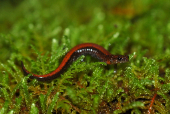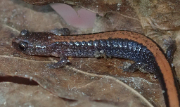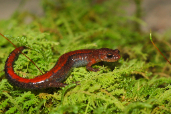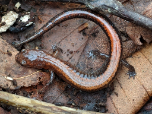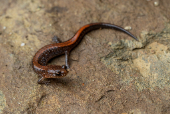Southern Red-Backed Salamander (Plethodon serratus)
Description: The southern red-backed salamander is typically gray or black in color, with a red-brown, fading stripe across the width of its back. It grows from 3 to 4 inches in length. Similar to Plethodon cinereus, Plethodon serratus comes in several atypical color variations. The typical red backed phase with a red dorsal stripe consists of most individuals. The atypical variations include a lead backed phase with a dark grey stripe, a silver back phase with a light grey dorsal stripe, hypomelanistic (leucistic) variations of the red backed form, and the rare white backed, or ghost phase. Unlike P. cinereus, P. serratus has not yet been found to have an erythristic variation.
Habitat: Mostly nocturnal, it is often found under ground debris in moist, forested areas. In dry seasons, it moves closer to permanent water sources.
Range: Southern Redback Salamanders are found in disjunct populations found in the mountains of west-central Arkansas, southeastern Oklahoma, central and southeastern Missouri, and the the northwestern third of Georgia.
Diet: Its primary diet is small arthropods and mollusks.
Reproduction: Courtship and mating likely take place between December and March in Missouri. Females lay eggs during late May or June. Presumably the eggs are attached to a thin stalk suspended from the top of a cavity in underground burrows, under rocks, clumps of moss, or rotten logs, as they are in many other Plethodon species. Usually 6 or 7 eggs are produced. Females remain with the eggs until they hatch, which is sometime between late July and August. The hatchlings begin to emerge on the surface in September and October. They become sexually mature after about 2 years of age.
Status: Listed as Least Concern in view of its wide distribution and presumed large population.
»» Kingdom: Animalia - Animals
»» Phylum: Chordata - Chordates
»» Subphylum: Vertebrata - Vertebrates
»» Class: Amphibia - (Amphibians)
»» Order: Caudata - Salamanders
»» Family: Plethodontidae - Lungless Salamanders
»» Genus: Plethodon
»» Species: Plethodon serratus - Southern Red-Backed Salamander
This article uses material from the Wikipedia article "Southern Red-Backed Salamander", which is released under the Creative Commons Attribution-Share-Alike License 3.0. Content may have been omitted from the original, but no content has been changed or extended.
|



